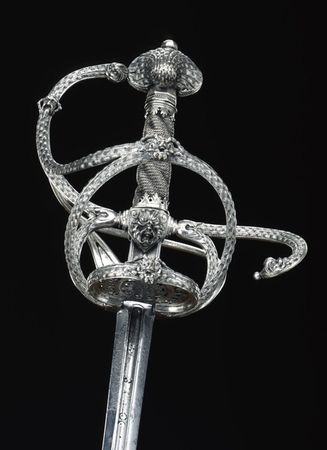"The Noble Art of the Sword: Fashion and Fencing in Renaissance Europe" at the Wallace Collection
Parade costume of Christian II, Elector of Saxony (1583-1611). Signed ‘Biberach’. Provenance Electors of Saxony. Rüstkammer, Staatliche Kunstsammlungen, Dresden, i.7
LONDON.- Witness the cutting edge of fashion as you’ve never seen it before! This exhibition tells the untold story of this fascinating and little known area of Renaissance art: revealing the fantastically skilled artistry behind the rapier; at once a weapon, fashion item, and rich jewellery object; representing the rise of a new and upwardly mobile middle class, sixteenth-century concepts of masculinity and the emergence of the duel of honour.
Summer 2012 represents the perfect opportunity to investigate the historical and social development of the ancient art of sword-fighting. The modern sport of fencing is one of the nine original Olympic sports but is also a piece of a much older story which began with the Renaissance fashion for carrying and fighting with swords in everyday life. A man of means in the sixteenth century went nowhere without his sword, and was always prepared to use it.
The Noble Art of the Sword: Fashion and Fencing in Renaissance Europe comprises exquisite and deadly weapons and other works of art from the Wallace Collection, the Victoria and Albert Museum, the Royal Armouries, and British private collections, brought together with stunning princely weapons and costume from some of the greatest continental collections, including Vienna and Dresden, exhibited in Britain for the first time. The very best sixteenth- and early seventeenth-century swords will be seen alongside beautifully illustrated fencing manuals from the Howard de Walden Library, on long-term loan to the Wallace Collection, while portraits, design books and documents will help place the Renaissance rapier in its social and artistic context to tell us more about the men who owned and used it.
During the Renaissance civilian swords were not just weapons: they were works of art. A bewildering variety of decorative techniques went into creating the finest rapiers: fire-gilding, damascening, enamelling, steel-carving and encrusting with precious metals and fine jewels. The rapier of the Holy Roman Emperor Maximilian II (1527-1576), never before seen in Britain, is the paragon of the art of the sword. Modelled with unbelievable skill in solid gold, the hilt, glittering with multi-coloured enamel in many bright colours, is set onto a deadly Milanese blade of the very best quality. Such high-status weapons were highly complex and individualistic, demanding enormous sums from those determined to impress their world.
Sword workshops also created buckles, buttons, and all the other mounts and fittings needed to seamlessly integrate the sword with the whole gentlemanly costume. One exceptional example on display is the rapier of Elector Christian II of Saxony (1583-1611), displayed for the first time alongside its matching doublet and breeches, cut from the finest Italian silk.
The evolution of the sword as a literally razor-sharp fashion statement represents an important social phenomenon. In the medieval period the wearing of swords in a non-military context was strongly discouraged. The sword was the tool and symbol of the warrior elite, the knights. This all changed as the Renaissance period ushered in the rise of a new elite class who not only had the means to follow the latest opulent fashions, but set the trends, often appropriating the traditional status symbols of the nobility. A beautiful sword was the Rolex of its day: the proud wearing of it was a statement of its owner’s status and power.
The dramatic increase in the carrying of swords, and specifically the appearance of the long, thrusting rapier, helped make the Renaissance world an increasingly dangerous place, one in which duelling (though technically illegal) became commonplace and a whole training community developed to service this new fashion. The sword was as much a daily accessory then as a mobile phone is today, but its use left people dead in the street.
In the Renaissance, there were no boundaries separating beauty and brutality, the work of art from the killing tool. The sword was both a splendid and a savage object, whilst the art of defence, or ‘fencing’, was regarded as an aesthetically pleasing movement system with just as much expressive value as a courtly dance. The ability to kill an enemy in a beautiful way was one of the essential attributes of nobility and as the aspiring middle classes began to emulate the elite, the duelling sub-culture grew. The arrest of the playwright Ben Jonson after killing a man in a duel, and the death of Christopher Marlowe in a brawl were just two famous results of its rapid spread in Elizabethan London.
The business of the fencing master was a popular culture with its own celebrities. Great artists like Albrecht Dürer illustrated fencing or ‘fight’ manuals, which presented the art of sword-fighting as both an art and a science. The exhibition will display a range of these beautiful manuals, from the Howard de Walden Library, by such masters as Ridolfo Capo Ferro, Camillo Agrippa and Achille Marozzo, which reveal a focus on skill, body forms, precision, fashion, and at times, gruesome results. They are a previously unseen and largely unknown treat; a rare window into life in the great Renaissance cities of Europe. Alongside them will be exhibited sixteenth-century training weapons designed specifically for different schools of fencing: from rapier and dagger fighting to the more obvious precursors of the modern day sport of fencing.
Visitors will hopefully leave with a new understanding of this often underappreciated Renaissance art form. The journey of discovery will settle on a time in history where art, sport and science converged, with the spotlight turned on virtuoso craftsmanship and its fascinating social history.
Rapier, Saxon, Dresden, the blade Solingen, c. 1608. Provenance Electors of Saxony. Rüstkammer, Staatliche Kunstsammlungen, Dresden, VI.370 and XI.4

/https%3A%2F%2Fprofilepics.canalblog.com%2Fprofilepics%2F1%2F0%2F100183.jpg)
/https%3A%2F%2Fstorage.canalblog.com%2F03%2F02%2F119589%2F96711876_o.jpg)
/https%3A%2F%2Fstorage.canalblog.com%2F11%2F31%2F119589%2F94773502_o.jpg)
/https%3A%2F%2Fstorage.canalblog.com%2F20%2F83%2F119589%2F94772815_o.jpg)
/https%3A%2F%2Fstorage.canalblog.com%2F26%2F72%2F119589%2F75604929_o.jpg)
/https%3A%2F%2Fstorage.canalblog.com%2F59%2F60%2F119589%2F26458628_o.jpg)




/http%3A%2F%2Fstorage.canalblog.com%2F78%2F88%2F119589%2F126226333_o.jpg)
/http%3A%2F%2Fstorage.canalblog.com%2F69%2F72%2F119589%2F122404760_o.jpg)
/http%3A%2F%2Fstorage.canalblog.com%2F85%2F15%2F119589%2F122404663_o.jpg)
/http%3A%2F%2Fstorage.canalblog.com%2F55%2F26%2F119589%2F122404554_o.jpg)